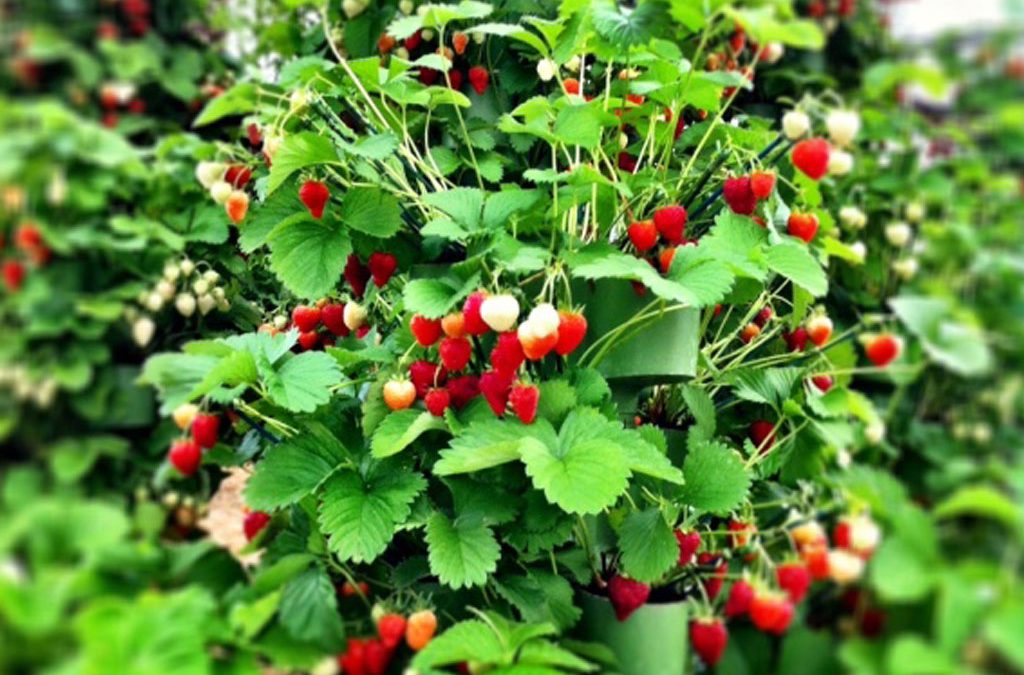
Growing Strawberries with the EzGro System
In the late 90’s, a vertical plant growing system was developed by EzGro. The new vertical system for growing vegetables, flowers, herbs and strawberries was a big improvement over previous vertical systems. This method of growing will surely offset the ever increasing cost of labor, energy and capital equipment in the future. The system can be used for many crops and is adaptable to all climates, even outdoors or under a semi-protected cover. Plus, it is inexpensive to purchase and easy to set install.
This patented column planter growing system consists of a stack of high density polyethylene containers that nest for shipping. They are turned 90 degrees to stack and become a unique vertical growing system. This growing system holds four plants per pot or 20 to 64 plants per stack. This stack takes up less than one and a half square feet of floor space. Spaced out for the crops intended and the light availability, the system is capable of producing 6 to 8 times as much per square foot as the equivalent field crop and 3 to 4 times as much as greenhouse bench crops. The plant density for a field crop of strawberries, lettuce, spinach and herbs is approximately 0.34 plants per square foot or 14,520 plants per acre. This is based on row spacing of 36 inches and plant spacing within the rows of 12 inches. For an EzGro system outdoors in stacks of 5 pots, and 4 plants per pot, the plant density is 80,000 plants per acre. At 8 pots in a stack it is 128,000 plants per acre.
The system was designed for strawberries, but can be used for other crops including herbs, leaf lettuce, spinach and certain floral crops such as ferns, pothos plants, ivy plants and edible flowers such as nasturtiums and violas. The list of plants that the EzGro System will grow is extensive.
Agricultural and Horticultural Uses
The EzGro system has potential for strawberries because the crop has a very high value and it has a small root system. Strawberries are susceptible to soil pathogens such as nematodes and leaf diseases such as anthracnose. However, with the EzGro System, strawberries and other crops are less likely to get root diseases because there is no soil. Everything is grown in various percentages of GroRock and Coconut Coir. Starter strawberry plants will all be grown in soilless or organic medium in the future so there will be no transfer of diseases from soil grown transplants. Soil pathogens are a world wide problem that has been treated for decades with a chemical called methyl-bromide. It has to be injected into the soil on every crop or the strawberries, and other crops, will not survive. With the EzGro System, this is a worry of the past because no chemicals are needed for soil sterilization.
The strawberry produced in the EzGro System is much more uniform and produces up to 10 times more long stem strawberries than in the field. The reason is quite simple. The berries hang over the pot and there is nothing to interfere with uniform growth. However, consistent watering and balanced feeding, in a controlled environment, is the primary reason for the long stems and the uniformity. This is a premium berry that brings a premium price. Herbs, such as basil, thyme, arugula, chives and oregano, do especially well in this system. As an added advantage, the pots with four strawberry plants or herb plants can be sold as portable gardens.
Planting and harvesting are much more efficient in the vertical system and there is very little replanting. In field strawberries, up to 15% of the plants may have to be replanted due to losses caused by a number of factors. Harvesting in the vertical system is done the same way as in the field except that there is far less stooping. Harvesting strawberries in this vertical system can be much more enjoyable, plus the weather doesn’t interfere. There are still many unanswered questions about the production of strawberries in greenhouses as well as the potential profits. These questions are not easy to answer and projections are based on ranges of production, or production per season, as well as a range of prices. The prices vary from $0.75 a pint to $3.00 a pint depending on the time of year and the competition from Florida and California. Many factors affect production such as light, day length, temperature, diseases and insects, type of plant and variety. The production is affected by the age of the plant, how it was stored, how long it was stored after shipping. The biggest factor in plant survival is where it was grown, when it was grown, how it was shipped, how long it was stored after shipping, how it was planted, and how it was grown immediately after planting. With this many variables it is easy to see why the production is so unpredictable.
We now have many new varieties and we know more about growing them than ever before. We have a better understanding of fertilizers for strawberries, better plants, and earlier more mature plants. In the past, harvesting on flat benches, triangular racks or hanging trays was difficult and expensive. Hanging bags never worked because a superstructure was needed, drainage was inconsistent, the root temperature was uncontrollable and the life of the bag was short under these conditions. The EzGro System solved these problems. The system is now low cost, durable, reusable, resalable, stackable, keeps the root temperature ideal, drains well, and is easy to replant.
Here is some general information that will be helpful on predicting production. Keep in mind that the most important factors affecting production is light, temperature, fertilization, and pollination.
Pollination is now very easy and is controlled by special bumble bees in a greenhouse or honey bee’s outdoors. Large uniform fruit will be limited without bumble bees or honey bees. To get an idea of how many honey bee hives are needed per acre of strawberries we look at what is need for field grown strawberries. We know that there 14,520 plants per acre and ideally you will need 3 honey bee hives per acre of strawberries. That means approximately one honey bee hive per 4840 plants for field grown strawberries. Now we know there are 80,000 plants per acre using 5 pots per stack in the EzGro system, which tells us we will, need approximately 16 honey bee hives per acre.
Fertilization is done with soluble, balanced hydroponic nutrients. The EzGro nutrients and the mixing instructions are quite simple.
The ideal temperature range is 55 to 80 degrees Fahrenheit so the range is obtainable in a greenhouse. This doesn’t mean that you have to have these exact temperatures to grow good strawberries. In fact, strawberries can survive in freezing temperatures and up to 100 degrees Fahrenheit. Ideally, one should attain to 50 to 55 degrees at night and 75 to 85 degrees during the day. Good light is essential and winter production in the northern states is based on available light and day length.
Early fall and winter production is essential because that is when prices are the highest. This has not been possible in the past because plants were not available early in the fall. The ideal schedule is to produce strawberries around the third week of November.

Caring For Your Strawberry Plants on Arrival

The Strawberry Plant
Trackbacks and pingbacks
No trackback or pingback available for this article.
0 comments
Leave a reply Delete Message
Articles
Featured
-
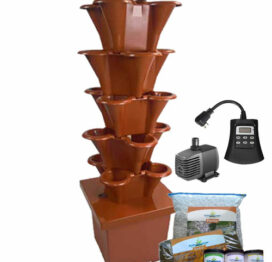 EzGro Patio GardenRegular Price $389.99 – $399.99
EzGro Patio GardenRegular Price $389.99 – $399.99 -
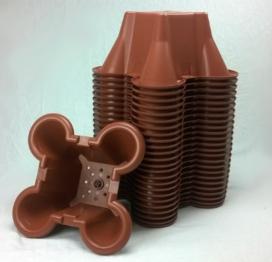 EzGro Quad Pot 25 PackRegular Price $274.99
EzGro Quad Pot 25 PackRegular Price $274.99 -
 Cold Pressed Neem OilRegular Price $29.92 – $38.71
Cold Pressed Neem OilRegular Price $29.92 – $38.71 -
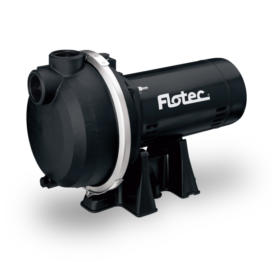 Thermoplastic Irrigation Pump 1 HPRegular Price $469.99
Thermoplastic Irrigation Pump 1 HPRegular Price $469.99 -
 Five Tower Deck GardenRegular Price $2,499.00
Five Tower Deck GardenRegular Price $2,499.00 -
 Vegetable Formula single dose SetRegular Price $29.99
Vegetable Formula single dose SetRegular Price $29.99 -
 EzGro Precision Micro TrimmerRegular Price $11.99
EzGro Precision Micro TrimmerRegular Price $11.99 -
 5000 Watt 48 Volt Power InverterRegular Price $899.00
5000 Watt 48 Volt Power InverterRegular Price $899.00 -
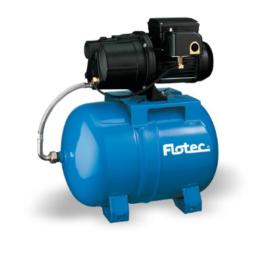 Rainwater Pressure Tank SystemRegular Price $449.00
Rainwater Pressure Tank SystemRegular Price $449.00 -
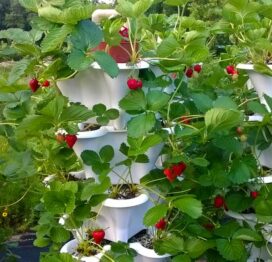 Five Tower Strawberry GardenRegular Price $2,799.00
Five Tower Strawberry GardenRegular Price $2,799.00









i am a big fan of this system!!
Best!!!!!